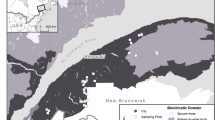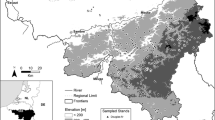Abstract
Key message
Presented Models describe the current growth rate. These models are good tools for growth prediction in the near future and will be compareable with further models; they will demonstrate the Norway spruce growth changes considering the climate change.
Abstract
Tree growth depends on genetic, climatic, microsite conditions and stand structure variations. A new evaluation method was carried out for studying mutual tree competition based on the social area of each trees. Nine Norway spruce (Picea abies (L.) Karst.) stands were investigated. The objectives of this study were to quantify each individual tree basal area increment during the years 2008–2012 with respect to the social area of the individual trees, competition indexes and the dendrometric characteristics of the trees. The social area of the trees in the investigated plots varied from 0.06 to 43.04 m2 where correlation coefficient (R 2) with each individual basal area increment was significantly high. Distance characteristics [e.g. minimum weighted distance (D i min) and maximum weighted distance (D i max)] provided a correlation coefficient (with individual tree basal area increments) varying from 0.69 to 0.84. Values of the R 2 between individual basal area increments and nearest trees dependent (NTD6) competition indexes varied from 0.41 to 0.66, while for distance-dependent competition indexes it varied from 0.59 to 0.78. To facilitate 5-year individual basal area increment inventories (I g5), linear models were used to develop the new specific functions. Individual tree growth models based on the distance measurement components and their combinations resulted in very high estimation accuracy. Therefore, the best model to determining basal area increment is the proven linear model using a social tree area, stem diameter at the breast height and crown length as input variables.










Similar content being viewed by others
References
Aakala T, Fraver S, D’amato AW, Palik BJ (2013) Influence of competition and age on tree growth in structurally complex old-growth forests in northern Minnesota, USA. For Ecol Manage 308:128–135
Anderson F, Brække FH, Hallbäcken L (1998) Nutrition and growth of Norway spruce forests in a Nordic climatic and deposition gradient. TemaNord, Nordic Council of Ministers, Copenhagen, p 255
Andreassen K, Tomter SM (2003) Basal area growth models for individual trees of Norway spruce, Scots pine, birch and broadleaves in Norway. For Ecol Manage 180:11–24
Bachmann M (1998) Indizes zur Erfassung der Konkurrenz von Einzelb¨aumen. MethodischeUntersuchung in Bergmischw¨aldern. Forstl Forschungsber M¨unchen 171:261
Biging GS, Dobbertin M (1995) Evaluation of competition indices in individual tree growth models. Forest Sci 41(2):360–377 (ISSN 0015-749X)
Butler AJ, Barbier N, Čermák J, Koller J, Thornily C, McEvoy C, Nicoll B, Perks MP, Grace J, Meir P (2010) Estimates and relationships between aboveground and belowground resource exchange surface areas in a Sitka spruce managed forest. Tree Physiology 30:705–714
Castagneri D, Vacchiano G, Lingua E, Motta R (2008) Analysis of intraspecific competition in two subalpine Norway spruce (Picea abies (L.) Karst.) stands in Paneveggio (Trento, Italy). For Ecol Manage 255:651–659
Čermák J (1990) Calculation of operative areas in large trees—a manual. Mendel University of Agriculture and Forestry in Brno, Brno, p 160
Čermák P, Jankovský L, Cudlín P (2004) Risk evaluation of the climatic change impact on secondary Norway spruce stands as exemplified by the Křtiny training forest enterprise. J For Sci 50(6):256–262
Čermák J, Ulrich R, Staněk Z, Koller J, Aubrecht L (2006) Electrical measurement of tree root absorbing surfaces by the earth impedance method: 2. Verification based on allometric relationships and root severing experiments. Tree Physiol 26:1113–1121
Coomes DA, Allen RB (2007) Effects of size, competition and altitude on tree growth. J Ecol 95:1084–1097
Corona P, Ferrara A (1989) Individual competition indices for conifer plantations agric. Ecosyst Environ 27(1989):429–437
Dale VH, Joyce LA, McNulty S, Neilson RP, Ayres MP, Flannigan MD, Hanson PJ, Irland LC, Lugo AE, Peterson CJ, Simberloff D, Swanson FJ, Stocks BJ, Wotton BM (2001) Climate change and forest disturbances. Bioscience 51:723–734
Daniels RF, Burkhart HE, Clason TR (1986) A comparison of competition measures for predicting growth of loblolly pine trees. Can J For Res 16(6):1230–1237 (ISSN 1208-6037)
Dobbertin M (2005) Tree growth as indicator of tree vitality and of tree reaction to environmental stress: a review. Eur J For Res 124:319–333
Fraver S, D’Amato AW, Bradford JB, Jonsson BG, Jönsson M, Esseen PA (2014) Tree growth and competition in an old-growth Picea abies forest of boreal Sweden: influence of tree spatial patterning. J Veg Sci 25:374–385
Gerendiain AZ, Peltola H, Pulkkinen P, Ikonen VP, Jaatinen R (2008) Differences in growth and wood properties between narrow and normal crowned types of Norway spruce grown at narrow spacing in southern Finland. Silva Fenn 42:423–437
Griess VC, Knoke T (2013) Bioeconomic modelling of mixed Norway spruce—European beech stands: economic consequences of considering ecological effects. Eur J Forest Res 132(3):511–522
Gspaltl M, Bauerle W, Binkley D, Sterba H (2013) Leaf area and light use efficiency patterns of Norway spruce under different thinning regimes and age classes. Forest Ecol Manag 2013(288):49–59
Hann DW, Hanus ML (2002) Enhanced diameter-growth-rate equations for undamaged and damaged trees in southwest Oregon. Forest Research Lab., Res. Contrib. 39, Oregon State University, Corvallis, p 54
Hartmann H, Beaudet M, Mazerolle M, Messier C (2009) Sugar maple (Acer saccharum Marsh.) growth is influenced by close conspecifics and skid trail proximity following selection harvest. For Ecol Manage 258:823–831
Hegyi F (1974) A simulation model for managing jack-pine stands. In: Fries J (ed) Growth models for tree and stand simulation. Royal Collage of Forestry, Stockholm, pp 74–90
Kilpeläinen A, Routa J, Peltola H, Gerendiain AZ, Pulkkinen P, Kellomäki S (2010) Effects of genetic entry and competition on above ground biomass production of Norway spruce grown in southern Finland For. Ecol Manage 259(2010):2327–2332
Köstner B, Falge E, Tenhunen JD (2002) Age-related effects on leaf area/sapwood relationships, canopy transpiration and carbon gain of Norway spruce stands (Picea abies) in the Fichtelgebirge, Germany. Tree Physiol 22:567–574
Lévesque M, Saurer M, Siegwolf R, Eilmann B, Brang P, Bugmann H, Rigling A (2013) Drought response of five conifer species under contrasting water availability suggests high vulnerability of Norway spruce and European larch. Glob Chang Biol 19(10):3184–3199
Lindner M, Maroschek M, Netherer S, Kremer A, Barbati A, Garcia-Gonzalo J, Seidl R, Delzon S, Corona P, Kolström M, Lexer MJ, Marchetti M (2010) Climate change impacts, adaptive capacity, and vulnerability of European forest ecosystems. For Ecol Manage 259(4):698–709
Lorimer CG (1983) Tests of age-independent competition indices for individual trees in natural hardwood stands. For Ecol Manage 6:343–360
Losi CJ, Siccama TG, Condit R, Morales JE (2003) Analysis of alternative methods for estimating carbon stock in young tropical plantations. For Ecol Manage 184(1–3):355–368 (ISSN 0378-1127)
Mailly D, Turbis S, Pothier D (2003) Predicting basal area increment in a spatially explicit, individual tree model: a test of competition measures with black spruce. Can J For Res 33:435–443
Monserud RA, Sterba H (1996) A basal area increment model for individual trees growing in even- and uneven-aged forest stands in Austria. For Ecol Manage 80:57–80
Mu L (2004) Polygon characterization with the multiplicatively weighted voronoi diagram. Prof Geogr 56(2):223–239
Pelz DR (1978) Estimating individual tree growth with tree polygons. In: Fries J et al (ed) Growth models for long term forescasting of timber yields. VPI & SU, School of Forestry and Wildlife Resources FWS-1-78, pp 172–178
Petri H (1966) Versuch einer standortgerechten, waldbaulichen und wirtschaftlichen Standraumregelung von Buchen-Fichten-Mischbeständen. Mitteilungen aus der Landesforstverwaltung Rheinland-Pfalz 13:145
Phat NK, Knorr W, Kim S (2004) Appropriate measures for conservation of terrestrial carbon stocks—analysis of trends of forest management in Southeast Asia. For Ecol Manage 191(1–3):283–299 (ISSN 0378-1127)
Pretzsch H (1995) Zum Einfluß des Baumverteilungsmusters auf den Bestandeszuwachs. Allgemeine Forst- und Jagdzeitung 166(9/10):190–201
Pretzsch H (2009) Forest dynamics, growth and yield. From measurement to model. Springer, Berlin
Pretzsch H, Biber P (2005) A re-evaluation of Reineke’s rule and stand density index. Forest Science 51:304–320
Pretzsch H, Schütze G (2005) Crown allometry and growing space efficiency of Norway spruce (Picea abies (L.) Karst.) and European beech (Fagus sylvatica L.) in pure and mixed stands. Plant Biology 7:628–639
Pukkala T (1989) Methods to describe the competition process in a tree stand. Scand J For Res 4:187–202
Pukkala T, Kolstrom T (1987) Competition indices and the prediction of radial growth in scots pine. Silva Fennica 21(1):55–67
Reineke LH (1933) Perfecting a stand-density index for even-aged forests. J Agric Res 46:627–638
Stadt KJ, Huston C, Coates KD, Feng Z, Dale MRT, Lieffers VJ (2007) Evaluation of competition and light estimation indices for predicting diameter growth in mature boreal mixed forests. Ann For Sci 64:477–490
StatSoft, Inc. 2011. Statistica (data analysis software system), version 10. www.statsoft.com
Tomé M, Burkhart HE (1989) Distance-dependent competition measures for predicting growth of individual trees. For Sci 35(3):816–831 (ISSN 0015-749X)
Trasobares A, Pukkala T (2004) Using past growth to improve individual-tree diameter growth models for uneven-aged mixtures of Pinus sylvestris L. and Pinus nigra Arn. in Catalonia, north-east Spain. Ann For Sci 61:409–417
TriloByte Statistical Software Ltd (2013) QC Expert 3.3. Pardubice, Czech Republic
UNFCCC (United Nations framework convention on climate change) (1997) Kyoto protocol. http://unfccc.int/kyoto_protocol/items/2830.php
Vanclay JK (1994) Modelling forest growth and yield: applications to mixed tropical forests. CAB International, UK, pp 223–250
Vettenranta J (1999) Distance-dependent models for predicting the development of mixed coniferous forests in Finland. Silva Fenn 33(1):51–72
Weber P, Bugman H, Fonti P, Rigling A (2008) Using a retrospective dynamic competition index to reconstruct forest succession. For Ecol Manage 254:96–106
Weigelt A, Jolliffe P (2003) Indices of plant competition. J Ecol 91(5):707–720
Williamson TB, Price DT, Beverly J, Bothwell PM, Frenkel B, Park J, Patriquin MN (2008) Assessing potential biophysical and socioeconomic impacts of climate change on forest-based communities: a methodological case study. Natural Resources Canada, Canadian Forest Service, Northern Forestry Centre, Edmonton, Alberta. Information Report NOR-X-415E
Wykoff RW (1990) A basal area increment model for individual conifers in the northern rocky mountains. For Sci 36:1077–1104
Zhao J, Maguire DA, Mainwaring D, Wehage J, Kanaskie A (2013) Thinning mixed-species stands of Douglas-fir and western hemlock in the presence of Swiss needle cast: Guidelines based on relative basal area growth of individual trees. For Sci 60(1):191–199
Author contribution statement
Jan Krejza is expert for using Fieldmap tools and did major part of fieldwork and prepared major part of manuscript. Jan Světlík partly helped with fieldwork, prepared application for data analysis and went through the whole mathematical process. Radek Pokorný helped with manuscript preparation and with data interpretation.
Acknowledgements
This research were supported by project of IGA MENDELU in Brno—project No. 84/2013 Dynamika přirozené obnovy v ekologických podmínkách porostních mezer na příkladu ŠLP Křtiny, project No. TA02010945 supported by Technology Agency of the Czech Republic, and project co-funded by the European Union Seventh Framework Programme FP7 under Grant agreement no. 284181 “Trees4Future”.
Conflict of interest
The authors declare that they have no conflict of interest.
Author information
Authors and Affiliations
Corresponding author
Additional information
Communicated by R. Grote.
Rights and permissions
About this article
Cite this article
Krejza, J., Světlík, J. & Pokorný, R. Spatially explicit basal area growth of Norway spruce. Trees 29, 1545–1558 (2015). https://doi.org/10.1007/s00468-015-1236-x
Received:
Revised:
Accepted:
Published:
Issue Date:
DOI: https://doi.org/10.1007/s00468-015-1236-x




